古代中国文化英语版
中国传统文化简介(中英文并存)

Mr Meilanfang increases international communication between China and other countries as the forerunner who spreads Beijing opera abroad. He has visited Japan in 1919, 1924 and 1956. In 1930, he visited America. He visited Russia in 1935 and 1952, which gained him a high reputation. During this period he knew many famous artists, singers, dancers, writers and painters. Because of his travels, there was an improved culture understanding in many countries. From that time forward, Beijing opera is listed into the dictionary of international drama. Mr Meilanfang is the symbol of Chinese acting art and holds with him our pride.
李小龙简介 李小龙英文简介 李小龙传奇简介 姓名:李小龙 妮称:细凤 英文 名字:Bruce lee 生日:1940年11月27日;籍贯:广东顺德;星座:射手座; 身高:173CM;体重:65KG;血型:O;学历:西雅图华盛顿州立大学;婚 姻状况:已婚;讨厌的地方:虚伪的社交场合;常到的地方:健身房,图书 馆,公园;最喜欢的运动:技击术;最喜欢的动物:狗;最喜爱的国家:中 国;嗜好:练武,冥想,跳舞,阅读;优点:正直善良,智慧超群;缺点: 至今没发现;其它:妻子:琳达;儿子:李国豪;女儿:李香凝;个人座右 铭:以无法为有法,以无限为有限;最喜欢的歌曲:《当我死去时》李小龙 葬礼上就播了此曲,天妒英才,悲哉! 六十年代后期,李小龙回香港发展电 影事业,先后主演了《唐山大兄》、《精武门》、《龙争虎斗》、《猛龙过 江》等电影,引起世界轰动;最后一部电影是《死亡游戏》。1973年7月20 日因病逝世。李小龙的逝世,不仅是武术界的损失,而且是电影界的损失。 遗着有《截拳道》、《功夫纪录》、《双节棍法》、《截拳道研究》。世界 各地成立了李小龙学会,研究李小龙的武术造诣。 1999年李小龙获《时代》 杂志评为“二十世纪的英雄与偶像”。他一生短暂、充满传奇,功夫盖世、 流芳千秋! 李小龙的一生是短暂的,但却如同一颗耀眼的彗星划过国际武坛 的上空,对现代技击术和电影表演艺术的发展作出了巨大的贡献。他主演的 功夫片风行海外,中国功夫也随之闻名于世界。许多外文字典和词典里都出 现了一个新词:“功夫”。在不少外国人心目中的功夫就是中国武术,李小 龙也成了功夫的化身 。
介绍古代中国文化运动英语作文
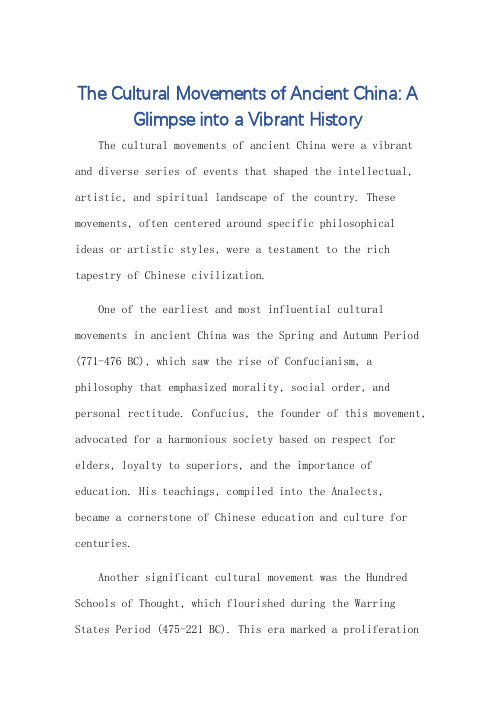
The Cultural Movements of Ancient China: A Glimpse into a Vibrant HistoryThe cultural movements of ancient China were a vibrant and diverse series of events that shaped the intellectual, artistic, and spiritual landscape of the country. These movements, often centered around specific philosophical ideas or artistic styles, were a testament to the rich tapestry of Chinese civilization.One of the earliest and most influential cultural movements in ancient China was the Spring and Autumn Period (771-476 BC), which saw the rise of Confucianism, a philosophy that emphasized morality, social order, and personal rectitude. Confucius, the founder of this movement, advocated for a harmonious society based on respect for elders, loyalty to superiors, and the importance of education. His teachings, compiled into the Analects, became a cornerstone of Chinese education and culture for centuries.Another significant cultural movement was the Hundred Schools of Thought, which flourished during the Warring States Period (475-221 BC). This era marked a proliferationof philosophical schools, each with its own unique ideasand perspectives. Schools such as Legalism, Taoism, Mohism, and Yangism competed for influence, contributing to a rich intellectual discourse that greatly influenced thepolitical and social landscape of China.The Han Dynasty (202 BC - 220 AD) saw the establishment of the Confucian canon, which formalized Confucianism asthe official ideology of the Chinese state. This move solidified Confucius's status as a cultural icon and led to the widespread adoption of Confucian values in Chinese society. The Han Dynasty also witnessed the development of new artistic forms such as calligraphy and painting, which became vehicles for expressing cultural and spiritual ideas. The Tang Dynasty (618-907 AD) marked a cultural renaissance in China, with a flourishing of poetry, art,and philosophy. This era saw the emergence of such literary giants as Du Fu and Wang Wei, whose poems captured thespirit of the times and became timeless classics. The Tang Dynasty also witnessed the development of new artisticstyles in painting and sculpture, as well as theintroduction of foreign influences from countries such as India and Persia.The Song Dynasty (960-1279 AD) was another era of cultural prosperity, marked by advancements in science, technology, and philosophy. The Song period saw the development of Neo-Confucianism, a reinterpretation of Confucian ideas that integrated Buddhist and Taoist elements. This movement强调了the importance of inner cultivation and self-realization, leading to a renewed focus on spiritual and intellectual pursuits.The Ming and Qing Dynasties (1368-1912 AD) saw the continuation of cultural traditions established in previous eras, while also witnessing the influence of foreign cultures through trade and contact with the West. This period marked the development of new literary genres such as novels and dramas, which provided a platform for exploring social issues and human psychology.The cultural movements of ancient China were not just expressions of intellectual and artistic pursuits; they were also agents of social change and progress. These movements shaped the values, beliefs, and aspirations ofthe Chinese people, leaving a lasting legacy that continues to influence Chinese culture today.**古代中国文化运动:活力四溢的历史一瞥**古代中国的文化运动是一系列充满活力和多样性的历史事件,它们塑造了国家的思想、艺术和精神面貌。
关于中国传统文化的英语演讲稿

hello everyone,today i want to say something about chinese traditional culture . our chinese nation, with its industriousness and wisdom, has created a long andover-lasting history and a rich and colorful culture.as a chinese,we are supposedto understand the traditional culture and realize its importance. first,what’s the traditional chinese culture .traditional chinese cultureincludes material and moral products of ancient chinese people. the moral productsinvolve confucianism, taoism, legalism, buddhism and social system. material onesinclude historic and cultural relics, ancient architectures etc.no matter how broadchinese culture is, the core of it is the moral. therefore.we can get an answer to another question.why should we learn chinesetraditional culture,or we can say what’s the value of chinese traditional culture.asthe core of chinese traditional culture is the moral, it can help us solve three majorproblems we are facing nowadays:problems of survival between man and nature;crisisof confidence between man and society;psychological problems exist in people ourselves. for example,confucius believed that persuit of fortune is a general desire ofhuman, but it most be limited by morality. people live for morality but not for fortune,and only in this way does life have value. if all the people in the society can realizethis ,horse storm would not appear.弘中化传统文化,展名校学子风采尊敬的各位领导、老师,亲爱的同学们,大家好!我是来自***。
古代中国文化英语版

古代中国文化英语版Ancient Chinese CultureChina, with its rich history spanning thousands of years, has a unique and vibrant ancient culture that continues to captivate people around the world. From its distinct philosophy to its magnificent art and architecture, Chinese culture offers a treasure trove of knowledge and wisdom. In this article, we will delve into various aspects of ancient Chinese culture, providing an overview of its key elements in an accessible and concise manner.1. Philosophy:At the heart of ancient Chinese culture lies a profound philosophical tradition that includes Confucianism, Daoism, and Buddhism. Confucianism emphasizes the importance of ethics, social harmony, and filial piety. Daoism promotes living in harmony with nature and cultivating the Dao, or the Way. Buddhism, originating in India but deeply integrated into Chinese culture, teaches the path to enlightenment and compassion towards all living beings. These philosophies have shaped the moral and ethical values of Chinese society for centuries.2. Language and Writing:The Chinese language, with its distinctive characters, is one of the oldest and most complex writing systems in the world. Each character represents a concept or idea and is composed of various strokes that must be written in a specific order. The Chinese writing system has played a crucial role in preserving ancient literature, historical records, and philosophical teachings.Chinese calligraphy, the art of writing beautifully, is highly regarded and often considered a meditative practice.3. Literature and Poetry:Chinese literature boasts a rich tradition that encompasses various genres, including poetry, prose, novels, and dramas. Ancient Chinese poets, such as Li Bai and Du Fu, created timeless verses that continue to inspire readers worldwide. Poems were often written with delicate imagery and profound emotions, capturing the beauty of nature and expressing the complexities of human experience. Classics, such as "The Romance of the Three Kingdoms" and "Journey to the West," provide a glimpse into ancient Chinese society and its values.4. Music and Performing Arts:Music has always held a significant place in Chinese culture. Traditional Chinese music, with its distinct instruments such as the guqin and pipa, evokes a sense of tranquility and elegance. The performing arts, including opera and dance, combine music with visually stunning movements and elaborate costumes. Peking Opera, with its unique vocal techniques and stylized gestures, is a highly esteemed art form that showcases the grandeur of ancient Chinese culture.5. Art and Architecture:Ancient Chinese art and architecture are characterized by their beauty, intricacy, and symbolism. Traditional Chinese painting, known for its use of ink and brush, captures the essence of nature and conveys emotions through minimalist strokes. The Forbidden City in Beijing and the TerracottaWarriors in Xi'an are iconic examples of Chinese imperial architecture, displaying the grandeur and power of ancient dynasties. The art of pottery, including delicate porcelain and vibrant ceramics, is also highly esteemed in Chinese culture.6. Medicine and Traditional Practices:Chinese medicine, with its holistic approach to health, has been practiced for thousands of years. Concepts such as Yin and Yang, as well as the flow of Qi (life energy), are central to traditional Chinese medicine. Acupuncture, herbal remedies, and tai chi are all part of this ancient healing tradition. Traditional practices, such as Feng Shui (the arrangement of space to promote harmony and balance) and Qigong (a practice combining movement, meditation, and breath control), are still widely followed today.In conclusion, ancient Chinese culture is a vast and diverse tapestry woven with philosophy, literature, art, and traditional practices. Its influence can be felt in various aspects of modern Chinese society and has captivated people worldwide. By understanding and appreciating this rich cultural heritage, we can gain valuable insights into the wisdom and traditions that have shaped China throughout history.。
中国传统文化英语优秀作文参考范文
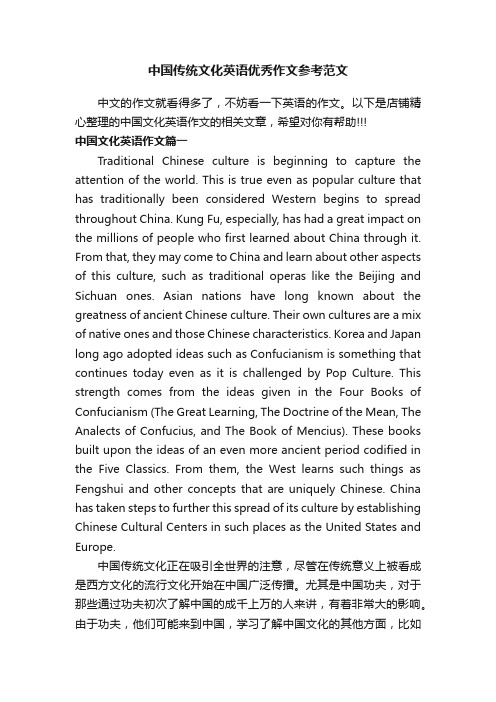
中国传统文化英语优秀作文参考范文中文的作文就看得多了,不妨看一下英语的作文。
以下是店铺精心整理的中国文化英语作文的相关文章,希望对你有帮助中国文化英语作文篇一Traditional Chinese culture is beginning to capture the attention of the world. This is true even as popular culture that has traditionally been considered Western begins to spread throughout China. Kung Fu, especially, has had a great impact on the millions of people who first learned about China through it. From that, they may come to China and learn about other aspects of this culture, such as traditional operas like the Beijing and Sichuan ones. Asian nations have long known about the greatness of ancient Chinese culture. Their own cultures are a mix of native ones and those Chinese characteristics. Korea and Japan long ago adopted ideas such as Confucianism is something that continues today even as it is challenged by Pop Culture. This strength comes from the ideas given in the Four Books of Confucianism (The Great Learning, The Doctrine of the Mean, The Analects of Confucius, and The Book of Mencius). These books built upon the ideas of an even more ancient period codified in the Five Classics. From them, the West learns such things as Fengshui and other concepts that are uniquely Chinese. China has taken steps to further this spread of its culture by establishing Chinese Cultural Centers in such places as the United States and Europe.中国传统文化正在吸引全世界的注意,尽管在传统意义上被看成是西方文化的流行文化开始在中国广泛传播。
关于中华传统文化的英语作文范文
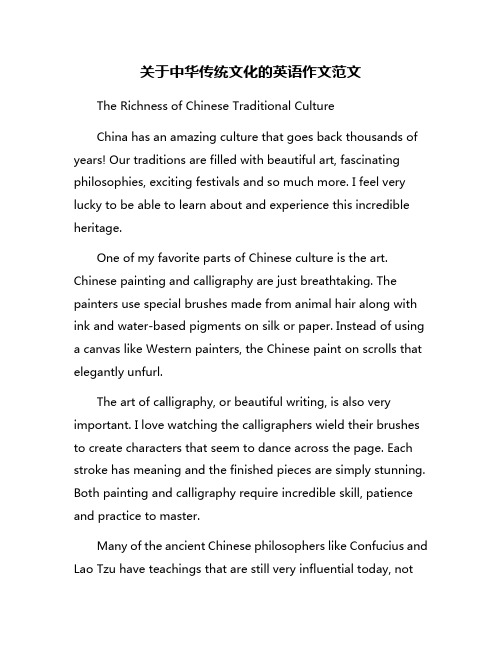
关于中华传统文化的英语作文范文The Richness of Chinese Traditional CultureChina has an amazing culture that goes back thousands of years! Our traditions are filled with beautiful art, fascinating philosophies, exciting festivals and so much more. I feel very lucky to be able to learn about and experience this incredible heritage.One of my favorite parts of Chinese culture is the art. Chinese painting and calligraphy are just breathtaking. The painters use special brushes made from animal hair along with ink and water-based pigments on silk or paper. Instead of using a canvas like Western painters, the Chinese paint on scrolls that elegantly unfurl.The art of calligraphy, or beautiful writing, is also very important. I love watching the calligraphers wield their brushes to create characters that seem to dance across the page. Each stroke has meaning and the finished pieces are simply stunning. Both painting and calligraphy require incredible skill, patience and practice to master.Many of the ancient Chinese philosophers like Confucius and Lao Tzu have teachings that are still very influential today, notjust in China but around the world. Confucianism emphasizes principles like filial piety, ritual, etiquette and morality. Daoism promotes the idea of living in harmony with nature and the universe.Another philosophy I find interesting is the concept of yin and yang and the pursuit of balance and harmony between complementary forces in the universe. These ideas have helped shape the Chinese outlook on health, nutrition and wellbeing practices like acupuncture, herbal medicine and martial arts.Speaking of martial arts, that's an integral part of Chinese culture that I'm very intrigued by. Kung Fu movies are a huge part of modern popular culture, but the origins of martial arts like Shaolin Kung Fu go back centuries as techniques forself-defense, mental discipline and spiritual growth. I hope I can take some lessons and learn some of the amazing forms and skills.Chinese festivals are a highlight every year as we celebrate things like the Lunar New Year, the Lantern Festival, the Dragon Boat Festival and many others. These special days are filled with incredible food, vibrant decorations, exciting activities and lots of joy and community spirit.For Lunar New Year, which is the most important festival, we have big family reunion dinners with dishes like dumplings and sweet desserts. The streets come alive with red lanterns, firecrackers and decorated doorways. At the Lantern Festival, we admire the beautiful glowing lanterns of all shapes and sizes. For the Dragon Boat Festival, we watch the intense dragon boat races and eat special rice dumplings called zongzi. Every festival is a wonderful cultural experience.Another amazing part of Chinese culture is the variety of delicious cuisines from different regions across the vast country. In the north, they have foods like Peking duck, dumplings, noodles and breads made with wheat. In the south, the cuisine features rice, dim sum, stir fries and lots of fresh seafood. In the west, the flavors are influenced by Middle Eastern and Central Asian cultures with dishes like cumin lamb and naan breads. Every bite is a tasty adventure!When it comes to literature, we have access to some of the greatest stories, fables and writings in the world from across China's extensive history. My personal favorites are the classic novels like Journey to the West, Romance of the Three Kingdoms and Dream of the Red Chamber. These epic tales transport youto another world filled with complex characters, drama, humor and insight into the values and traditions of ancient China.Traditional Chinese architecture is another highlight with incredible palaces, temples, pagodas and gardens. Many of these ancient sites took amazing skill and years of labor to construct using philosophies like feng shui to find harmonious balances and alignments. Just walking through places like the Forbidden City or the Temple of Heaven fills me with a sense of wonder and appreciation for my ancestors' achievements.The clothing and accessories in traditional Chinese culture are also exquisite. From the embroidered silk robes and gowns to the ornate hair pins and jewelry, every piece is a work of art. Even today's qipao dresses are elegant modern representations of these ancient fashions. I love seeing the different styles and adornments for different classes and occasions.Overall, I feel extremely fortunate to grow up surrounded by such a vast, vibrant and meaningful cultural heritage. From the arts to the philosophies, festivals, cuisines, literature, architecture and fashions - Chinese culture has had such an immense impact on society for thousands of years. By learning about and appreciating our traditions, I have a deeper understanding of who I am and where I come from. It fills me with great pride andmotivation to help continue these incredible legacies for future generations to enjoy.。
有关中国传统文化的英语完形

有关中国传统文化的英语完形全文共四篇示例,供读者参考第一篇示例:China has a rich and diverse traditional culture that has been passed down through generations. From ancient philosophy to traditional art forms, Chinese culture has greatly influenced the world and continues to be cherished by many. In this article, we will explore some aspects of traditional Chinese culture and its significance.第二篇示例:中国是一个拥有悠久历史和丰富传统文化的国家,其传统文化是中华民族的瑰宝,代代相传,传承至今。
中国传统文化包括诗词歌赋、书法绘画、传统音乐、传统戏曲、传统建筑等方面,每一种都有着深厚的文化底蕴。
中国古代诗词是中国传统文化的重要组成部分,代表作品如李白的《静夜思》、苏轼的《水调歌头》等,这些诗词流传至今,被后人传颂。
诗词以其简洁而优美的语言,描绘了古代人们的生活和情感,展现了他们的审美情趣和人生哲理。
书法是中国传统文化中的瑰宝,中国的书法源远流长,有着悠久的历史传统。
中国的书法有楷书、行书、草书、隶书等不同的体裁,每一种都有其独特的魅力。
通过书法,人们可以感受到中国文化的深厚底蕴和精神内涵,体味到其中蕴含的美学和哲学。
传统音乐是中国传统文化的重要组成部分,古代的音乐以古琴、笙、箫等乐器为主,具有独特的音乐风格和特色。
中国传统音乐中融入了中国人的审美情趣和生活哲学,展现了中华民族的文化底蕴和民族精神。
传统戏曲是中国传统文化的瑰宝,有京剧、昆曲、评剧等不同的戏曲体裁,每一种都有其独特的艺术风格和表现形式。
中国历史文化英语单词
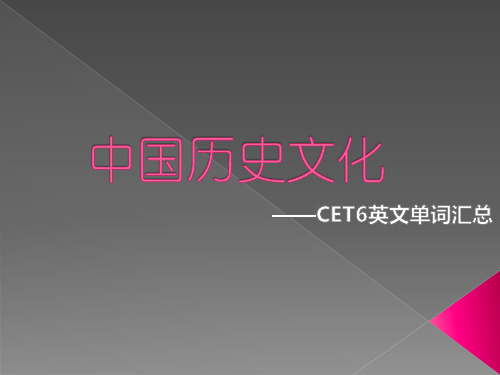
扬州菜 Yangzhou cuisine 月饼 moon cake 年糕 rice cake 油条 deep-fried dough sticks 豆浆 soybean milk 馒头 steamed buns 花卷 steamed twisted rolls 包子 steamed stuffed buns 北京烤鸭 Beijing roast duck 拉面 hand-stretched noodles 馄饨 wonton (dumplings in soup) 豆腐 tofu? bean curd 麻花 fried dough twist 烧饼 clay oven rolls 皮蛋 100-year egg; century egg 蛋炒饭 fried rice with egg
社会地位social status
1.不可分割的一部分:可译为an integral part。 2.为振兴华夏做出了巨大的贲献:可译为has made great contributions to the prosperity of China,其中“华夏”: 即“中国”或“中华”,可直接译为China; “振兴”此处翻译 成了名词形式prosperity,还可译为revitalization;“做出了 巨大 的贡献”可译为 has made great contributions。 3.并驾齐驱:此处指两者(中医和西医)都得以应用,可简 单地翻译为both are being used。 4.独特的诊断手法、系统的治疗方式和丰富的典籍材料: 三个并列的名词短语,可分别译为unique : I diagnostic methods, systematic approach和abundant historical literature and materials; “典籍材料”可理解为历史文献资料, 翻译为historical literature and materials。 5.引导并促进这一新兴产业的研究和开发:“引导”译为 guide; “促进”可译为promote,还可译为facilitate或 further; “新兴产业,,可译为promising industry,还可译为 new industry或emerging industry。 6.中医疗法:译为Chinese medication。
高考英语作文范文5篇 中国传统文化
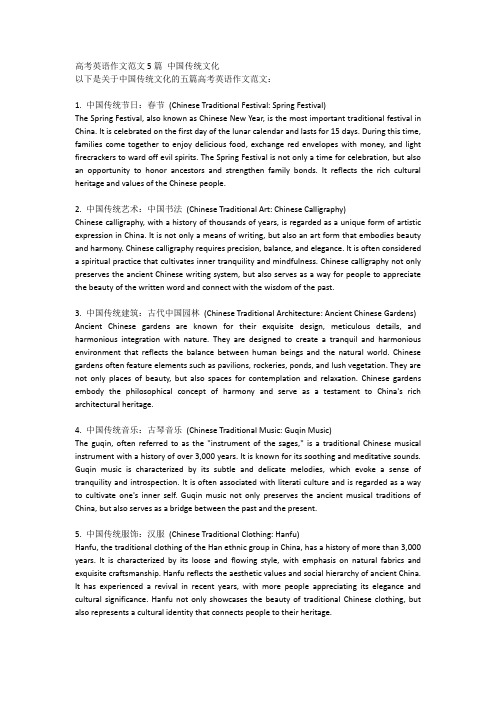
高考英语作文范文5篇中国传统文化以下是关于中国传统文化的五篇高考英语作文范文:1. 中国传统节日:春节(Chinese Traditional Festival: Spring Festival)The Spring Festival, also known as Chinese New Year, is the most important traditional festival in China. It is celebrated on the first day of the lunar calendar and lasts for 15 days. During this time, families come together to enjoy delicious food, exchange red envelopes with money, and light firecrackers to ward off evil spirits. The Spring Festival is not only a time for celebration, but also an opportunity to honor ancestors and strengthen family bonds. It reflects the rich cultural heritage and values of the Chinese people.2. 中国传统艺术:中国书法(Chinese Traditional Art: Chinese Calligraphy)Chinese calligraphy, with a history of thousands of years, is regarded as a unique form of artistic expression in China. It is not only a means of writing, but also an art form that embodies beauty and harmony. Chinese calligraphy requires precision, balance, and elegance. It is often considered a spiritual practice that cultivates inner tranquility and mindfulness. Chinese calligraphy not only preserves the ancient Chinese writing system, but also serves as a way for people to appreciate the beauty of the written word and connect with the wisdom of the past.3. 中国传统建筑:古代中国园林(Chinese Traditional Architecture: Ancient Chinese Gardens) Ancient Chinese gardens are known for their exquisite design, meticulous details, and harmonious integration with nature. They are designed to create a tranquil and harmonious environment that reflects the balance between human beings and the natural world. Chinese gardens often feature elements such as pavilions, rockeries, ponds, and lush vegetation. They are not only places of beauty, but also spaces for contemplation and relaxation. Chinese gardens embody the philosophical concept of harmony and serve as a testament to China's rich architectural heritage.4. 中国传统音乐:古琴音乐(Chinese Traditional Music: Guqin Music)The guqin, often referred to as the "instrument of the sages," is a traditional Chinese musical instrument with a history of over 3,000 years. It is known for its soothing and meditative sounds. Guqin music is characterized by its subtle and delicate melodies, which evoke a sense of tranquility and introspection. It is often associated with literati culture and is regarded as a way to cultivate one's inner self. Guqin music not only preserves the ancient musical traditions of China, but also serves as a bridge between the past and the present.5. 中国传统服饰:汉服(Chinese Traditional Clothing: Hanfu)Hanfu, the traditional clothing of the Han ethnic group in China, has a history of more than 3,000 years. It is characterized by its loose and flowing style, with emphasis on natural fabrics and exquisite craftsmanship. Hanfu reflects the aesthetic values and social hierarchy of ancient China. It has experienced a revival in recent years, with more people appreciating its elegance and cultural significance. Hanfu not only showcases the beauty of traditional Chinese clothing, but also represents a cultural identity that connects people to their heritage.以上是关于中国传统文化的五篇高考英语作文范文,希望对你有所帮助。
高中英语 高考英语作文 有关中国传统文化的范文5篇

高中英语高考英语作文有关中国传统文化的范文5篇1. 传统节日——春节(Traditional Festival - Spring Festival)The Spring Festival, also known as Chinese New Year, is the most important traditional festival in China. It is a time for family reunions and celebrations. During this festival, people clean their houses, decorate them with red lanterns and couplets, and set off fireworks to drive away evil spirits. They also visit relatives and friends, exchange gifts, and enjoy traditional food such as dumplings and rice cakes. The Spring Festival reflects the values of family, unity, and good fortune, and it playsa significant role in promoting Chinese culture.2. 传统音乐——古琴(Traditional Music - Guqin)Guqin, a traditional Chinese musical instrument, has a history of over 3,000 years. It is often referred to as the "instrument of the sages" and is known for its elegant and serene sound. Playing the guqin requires skill and patience, as it involves intricate finger techniques and a deep understanding of Chinese culture. The music produced by guqin is not only pleasing to the ear but also has a profound cultural significance. It reflects the philosophy of harmony and balance, and it is considered a symbol of traditional Chinese aesthetics.3. 传统艺术——京剧(Traditional Art - Peking Opera)Peking Opera, with its colorful costumes, elaborate makeup, and unique singing style, is one of the most renowned traditional art forms in China. It combines music, dance, acrobatics, and martial arts to tell stories from Chinese history and folklore. Peking Opera requires performers to have a high level of skill, including vocal techniques, body movements, and facial expressions. It embodies the essence of Chinese culture, with its emphasis on morality, loyalty, and the pursuit of beauty. Peking Opera continues to be appreciated by audiences both in China and around the world.4. 传统建筑——古代宫殿(Traditional Architecture - Ancient Palaces)Ancient palaces in China, such as the Forbidden City in Beijing, are a testament to the grandeur and magnificence of traditional Chinese architecture. These palaces were built with meticulous craftsmanship and designed according to strict principles of feng shui. They often feature intricate carvings, exquisite paintings, and beautiful gardens. Beyond their architectural beauty, these ancient palaces also serve as historical and cultural landmarks, preserving the legacy of ancient Chinese dynasties and reflecting the power and authority of the emperors.5. 传统文化——中国书法(Traditional Culture - Chinese Calligraphy)Chinese calligraphy, a unique form of artistic expression, has a long history and is highly regarded as a quintessential part of Chinese culture. It involves using a brush and ink to write characters, with an emphasis on the balance, rhythm, and beauty of the strokes. Chinese calligraphy not only serves as a means of communication but also embodies the essence of Chinese philosophy, literature, and aesthetics. It requires years of practice and discipline to master, and it is considered both a form of art and a spiritual practice that cultivates one's character and appreciation for beauty.。
中国古代文化词汇英文版
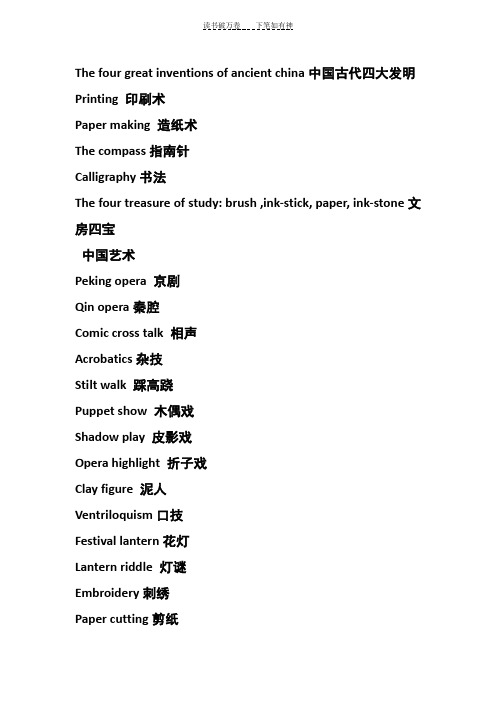
The four great inventions of ancient china中国古代四大发明Printing 印刷术Paper making 造纸术The compass指南针Calligraphy书法The four treasure of study: brush ,ink-stick, paper, ink-stone文房四宝中国艺术Peking opera 京剧Qin opera秦腔Comic cross talk 相声Acrobatics杂技Stilt walk 踩高跷Puppet show 木偶戏Shadow play 皮影戏Opera highlight 折子戏Clay figure 泥人Ventriloquism口技Festival lantern花灯Lantern riddle 灯谜Embroidery刺绣Paper cutting剪纸Acupuncture 针灸Traditional chinese painting 中国画Chinese brush painting水墨画Chinese knot中国结中国美食Snack bar小吃摊Moon cake 月饼Rice cake年糕Deep fired dough sticks 油条Soybean milk 豆浆Steamed buns 馒头Hand-stretched noodles拉面Tofu ;bean curd 馄饨Fired rice with egg 蛋炒饭中国节日The lantern festival 元宵节The tomb-sweeping day 清明节The dragon-boat festival 端午节The mid-autumn day 中秋节The double-ninth day重阳节The double-seventh day 七夕节中国古典名著《大学》the great learning《中庸》the doctrine of the mean《论语》the analects of confucius《孟子》the mencius《孙子兵法》the art of war《三国演义》three kingdoms《西游记》journey to the west《红楼梦》dream of the red mansions《水浒传》heroes of the marshes《山海经》the classic of mountains and rivers 《资治通鉴》history as a mirror《春秋》the spring and autumn annals《史记》historical records《诗经》the book of songs《礼记》the book of rites《三字经》three-character scriptures中国旅游景点兵马俑 the mausoleum of emperor大雁塔 terracotta warriors and horses丝绸之路 the silk road敦煌莫高窟 Mogao grottoes华清池 huaqing hot springs 五台山jiuhua mountain。
英语中国文化关键词

中国文化关键词一、四大发明(The four Great Inventions of Ancient China)1.火药:gunpowder2.印刷术:printing3.造纸术:paper-making4.指南针:compass二、中国古代哲学家(Ancient China Philosopher)1.孔子:Confucius2.孟子:Mencius3.老子:Lao Tzu4.庄子:Chuang Tzu5.墨子:Mo Tzu6.孙子:Sun Tzu三、四书(The Four Books)1.《大学》:The Great Learning2.《中庸》:The Doctrine of the Mean3.《论语》:The Analects of Confucius4.《孟子》:The Mencius四、书法五大书体(The Five Major Style of China Calligraphy)1.篆书:seal script ; seal character2.隶书:official script ; clerical script3.行书:running script ; semi-cursive script4.草书:cursive script5.楷书:regular script ; standard script五、六艺(The Six Classical Arts)1.礼:rites2.乐:music3.射:archery4.御:riding5.书:writing6.数:arithmetic六、汉字(China Characters)1.汉字笔画:stroke2.偏旁部首:radical3.书写体系:writing system4.汉藏语系:Sino-Tibetan5.汉学家:Sinologist ; Sinologue6.中国热:Sinomania7.同宗同源:of the same origin8.华夏祖先:the China Characters9.单音节:single syllable10.声调:tone11.阳平、阴平、上声、去声level tone , rising tone , falling-rising tone , falling tone七、武术(The Martial Arts)1.中国武术:kong fu2.武术门派:school of martial arts3.习武健身:practice martial arts for fitness4.古代格斗术:ancient form of combat5.中国武协:China Martial Art Association6.武林高手:top martial artist7.气功:Qigong , deep breathing exercises8.柔道:judo9.空手道:karate 10.跆拳道:tae kwon do11.拳击:boxing12.摔跤:wrestling13.击剑:fencing14.武侠小说:tales of roving knights ; kung fu novel。
英语演讲稿中国文化
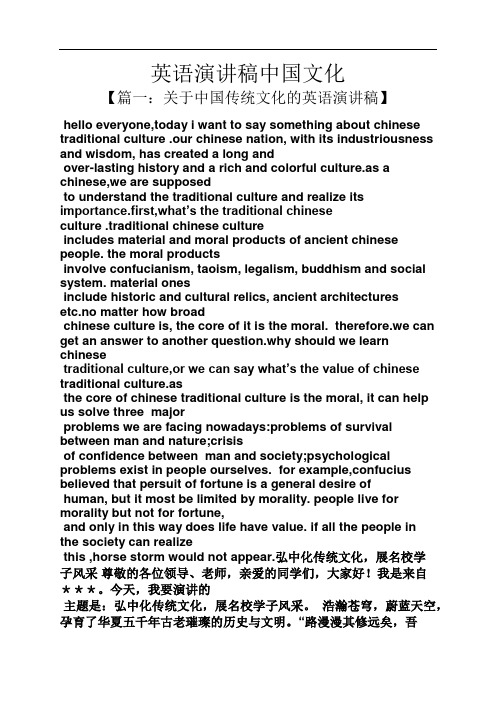
英语演讲稿中国文化【篇一:关于中国传统文化的英语演讲稿】hello everyone,today i want to say something about chinese traditional culture .our chinese nation, with its industriousness and wisdom, has created a long andover-lasting history and a rich and colorful culture.as a chinese,we are supposedto understand the traditional culture and realize its importance.first,what’s the traditional chineseculture .traditional chinese cultureincludes material and moral products of ancient chinese people. the moral productsinvolve confucianism, taoism, legalism, buddhism and social system. material onesinclude historic and cultural relics, ancient architecturesetc.no matter how broadchinese culture is, the core of it is the moral. therefore.we can get an answer to another question.why should we learnchinesetraditional culture,or we can say what’s the value of chinese traditional culture.asthe core of chinese traditional culture is the moral, it can help us solve three majorproblems we are facing nowadays:problems of survival between man and nature;crisisof confidence between man and society;psychological problems exist in people ourselves. for example,confucius believed that persuit of fortune is a general desire ofhuman, but it most be limited by morality. people live for morality but not for fortune,and only in this way does life have value. if all the people inthe society can realizethis ,horse storm would not appear.弘中化传统文化,展名校学子风采尊敬的各位领导、老师,亲爱的同学们,大家好!我是来自***。
中国传统文化介绍(英文版)

栏目索引与介绍•当前位置: 主页/•中外文化/中国文化随着中国加入世界贸易组织,中国将进一步对外开放,中国经济与世界经济更加融合。
因此,将中华民族悠久的历史和灿烂的文化介绍给世界各国人民是所有英语爱好者应尽的责任。
开辟这个栏目,就是为了适应对外宣传的需要。
我们将在此介绍中国历史、音乐、绘画、考古、旅游、经济、宗教等方面的情况。
那些从事中国文化教学与研究的师生会在这里找到一些参考资料和英语表达方式。
中国文化知识漫谈(中文)中国文化美国行(新闻报道与背景介绍)Culture Relics文化古迹Travel Features旅游Wushu/Qigong武术与气功Opera/Theatre戏曲Galleries/Museums美术馆与博物馆Peking Opera中国京剧Events/Festivals节日与民俗Local Opera中国地方戏Chinese New Year's Day中国新年来历与24节气Dance Drama and Ballet中国舞剧与芭蕾Traditions of Chinese New Year中国新年除夕习俗Modern Chinese Drama中国话剧Do's and Don'ts of Chinese New Year 中国新年禁忌Acrobatics, Puppet and Shadow Shows杂技、木偶戏与皮影The History of Lion Dance中国舞狮Quyi Performances中国曲艺表演The History of Fireworks中国鞭炮Paintings/Handicrafts绘画与工艺品Lantern Festival元宵节成语典故一 (三国演义、西游记)Brithday of Confucius孔子生日成语典故二Birthday of Mazoo妈祖生日成语典故三Dragon Boat Festival端午节成语典故四Moon Festival中秋节中国古代简史中国文学(包括古文、近代、现代与当代文学以及文化传统,作家传记)中国诗歌英译 (请综合训练中翻译技巧栏目)中国旅游《旅游英语》网络课程中国旅游十大特色中国西藏北京景点天坛中国美食故宫中国十二生肖:12 Taditional Zodiacs M usic音乐RAM HORSE Solo Recordings中国音乐独奏MONKEY ROOSTER CollectedRecordings中国音乐集锦SNAKE DRAGON TraditionalChinese中国传统乐器与音乐InstrumentalmusicDOG PIG Classical Music中国古典音乐OX TIGERRABBIT RAT中国文化知识漫谈(一)文化的含义什么叫文化?《易经》上说:“观乎天文,以察时变,观乎人文,以化成天下。
英语作文万能中国传统文化

Embracing the Richness of TraditionalChinese CultureThe essence of Traditional Chinese Culture, encompassing thousands of years of history, is a profound and diverse tapestry that reflects the wisdom, values, and lifestyles of the Chinese people. This rich cultural heritage, passed down through generations, is a testamentto the resilience and adaptability of the Chinese civilization.At the core of Chinese culture lies Confucianism, which emphasizes the importance of harmony, respect, andintegrity. Confucius's teachings on filial piety, loyalty, and righteousness have shaped the moral and ethical foundation of Chinese society. This philosophy, along with Taoism and Buddhism, has influenced Chinese art, literature, philosophy, and daily life, creating a unique blend of spirituality and practicality.Art and literature in China have always been areflection of society and history. The beautifulcalligraphy and intricate paintings of the ancient masters tell the stories of heroes, legends, and nature. Chineseliterature, from the classic poems of the Tang Dynasty to the novels of the Ming and Qing Dynasties, offers insights into the lives, thoughts, and emotions of the Chinese people.Traditional Chinese festivals and customs are also an integral part of the culture. The Spring Festival,庆祝新的一年的开始,is marked with family reunions, fireworks, and feasting. The Dragon Boat Festival,纪念古代爱国诗人屈原,features dragon boat races and the eating of zongzi, a traditional rice dumpling. These festivals not only celebrate the passing of time but also promote family unity and community spirit.Moreover, Chinese cuisine, regarded as one of the most diverse and delicious in the world, is a testament to the creativity and resourcefulness of the Chinese people. From the spicy Sichuan dishes to the delicate dim sum of Canton, Chinese food reflects the rich flavors and ingredients of the land, as well as the cultural exchanges with other nations.In conclusion, Traditional Chinese Culture is a vast and vibrant entity that has shaped the identity of theChinese nation and continues to influence people worldwide. It is a rich tapestry of art, literature, philosophy, festivals, and cuisine that offers insights into the values, aspirations, and dreams of the Chinese people. As we embrace the globalization of culture, it is important to appreciate and preserve the unique beauty of Traditional Chinese Culture, which remains a vital force in the contemporary world.**拥抱丰富多彩的中国传统文化**中国传统文化,历经数千年,其本质是一幅反映中国人民智慧、价值观和生活方式的深厚多彩画卷。
(完整版)中国文化英语翻译

Unit1 中国丝绸中国是丝绸的故乡。
栽桑、养蚕、缫丝、织绸是中国古代人民的伟大发明。
商周时期(前1600——前256)丝绸的生产技术就已发展到相当高的水平。
西汉(前206——公元25)时张蹇通西域,把中元与波斯湾、地中海紧密联系起来,开辟了中外交流贸易的新纪元。
从此中国的丝绸以其卓越的品质、精美的花色和丰富的文化内涵闻名于世,成为中国文化的象征、东方文明的使者。
Chinese SilkChina is the home of silk. Mulberry planting, sericulture, silk reeling and thickening are all great inventions of the ancient Chinese. As early as the Shang and Zhou Dynasties (1600-BC256BC), the Chinese people’s silk-weaving techniques had reached an extremely high level. During the Western Han Dynasty(206BC-25AD),Zhang Jian ,an outstanding diplomat ,traveled around central Asia and connected China with the Persian Gulf and the Mediterranean, opening up a new era of Sino-foreign trade, exchange and communication. From then on, China’s silk became well known for its extraordinary quality, exquisite design and color , and abundant cultural connotations. Hitherto, Chinese silk has been accepted as a symbol of Chinese culture and the emissary of oriental civilization.中国园林中国园林是把人造的山水、植物、建筑等与自然地貌有机结合的环境艺术,是我国古代建筑艺术的珍宝。
中国传统文化英语翻译整理新

1.香囊(scented sachet),古代也称“香袋”,通常是用布缝制或彩色丝线编织的袋子,里面塞满香草(aromatic herbs)。
香囊最初用来吸汗、驱虫和避邪。
香囊不仅有用,而且可作装饰品。
它们的形状和大小各异,有圆形、椭圆形和其他形状。
它们通常配有精致的图案,每个图案都象征着特别的含义。
例如,双鱼或成对蝴蝶图案象征男女之爱;莲花或牡丹花(peony flower)等图案象征女性;松树和仙鹤图案象征长寿;石榴(guava)图案象征很多孩子。
漂亮的香囊不仅是装饰品,而且含有丰富的文化和历史内涵。
翻译:Scented sachets, also called “fragrant bags” in ancient times, are bags usually sewed with cloth or weaved with multicolor silk threads and stuffed with aromatic herbs. The fragrant bags were originally used for absorbing sweat, repelling insects and warding off evils. Scented sachets are not only useful, but also ornamental. They come in different shapes and sizes, such as round, oval and many others. And they are normally decorated with elaborate patterns, with each pattern symbolizing a special meaning.For instance,a double-fish or double-butterfly pattern smybolizes the love between a man and a woman;patterns like lotus or peony flowers symbolize women;pine and crane patterns symbolize longevity and a guava pattern is the symbol of lots of children.A nice scented sachet is not just an ornament,but more of something that contains cultural and historical richness.2.中国民间艺术与中国哲学统一于“阴阳(yin-yang)生万物”这一理念。
中国传统文化 英语作文
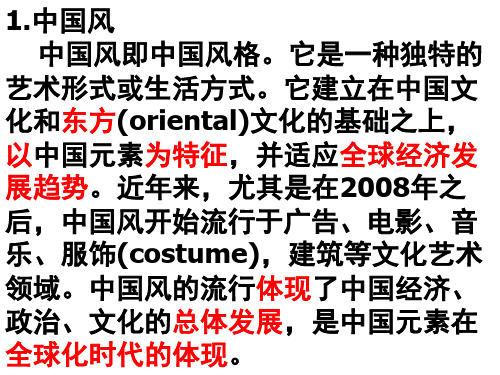
The Chinese calligraphy is a unique form of visual art. As a writing art peculiar to Chinese characters, it is reputed as ”nolanguage poetry, no-movement dance, nopicture painting and no-sound music”. Chinese characters are an important factor of Chinese calligraphy, which has originated and developed from Chinese culture, while Chinese characters are one of the basic elements of Chinese culture. A good handwriting was something that an ancient Chinese scholar felt very proud of. Nowadays, practicing Chinese calligraphy is generally considered as a good way to promote thinking and improve concentration.
4.中国龙 在中国文化中,龙有非常重要的地位
和影响。它是中国人想象出来的一种生 物,被中国人奉为神明,能够呼风唤雨, 主宰一切。在古代,人们认为它代表着 吉祥,能给人们带来福祉。自古以来中 国人就以龙作为自己的图腾totem,认为 自己是龙的子孙。古代的皇帝更是以龙 自居,认为龙象征着神圣的divine皇权。 龙已渗透了中国社会的各个方面,它成 为了中华民族的象征。
中国古代文化词汇英文版
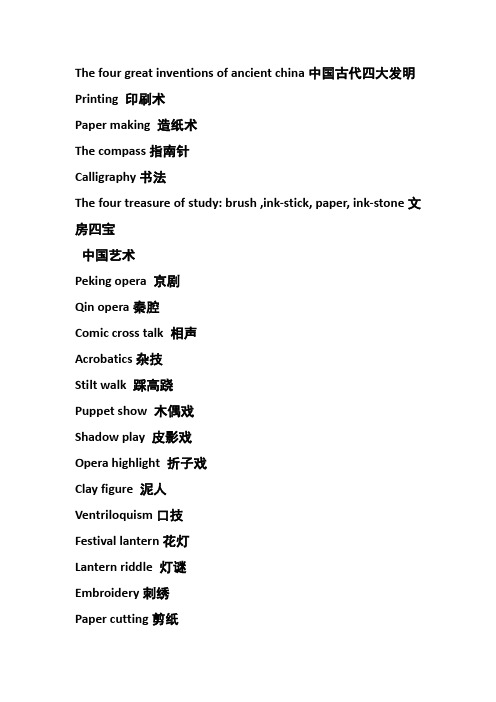
The four great inventions of ancient china中国古代四大发明Printing 印刷术Paper making 造纸术The compass指南针Calligraphy书法The four treasure of study: brush ,ink-stick, paper, ink-stone文房四宝中国艺术Peking opera 京剧Qin opera秦腔Comic cross talk 相声Acrobatics杂技Stilt walk 踩高跷Puppet show 木偶戏Shadow play 皮影戏Opera highlight 折子戏Clay figure 泥人Ventriloquism口技Festival lantern花灯Lantern riddle 灯谜Embroidery刺绣Paper cutting剪纸Acupuncture 针灸Traditional chinese painting 中国画Chinese brush painting水墨画Chinese knot中国结中国美食Snack bar小吃摊Moon cake 月饼Rice cake年糕Deep fired dough sticks 油条Soybean milk 豆浆Steamed buns 馒头Hand-stretched noodles拉面Tofu ;bean curd 馄饨Fired rice with egg 蛋炒饭中国节日The lantern festival 元宵节The tomb-sweeping day 清明节The dragon-boat festival 端午节The mid-autumn day 中秋节The double-ninth day重阳节The double-seventh day 七夕节中国古典名著《大学》the great learning《中庸》the doctrine of the mean《论语》the analects of confucius《孟子》the mencius《孙子兵法》the art of war《三国演义》three kingdoms《西游记》journey to the west《红楼梦》dream of the red mansions《水浒传》heroes of the marshes《山海经》the classic of mountains and rivers 《资治通鉴》history as a mirror《春秋》the spring and autumn annals《史记》historical records《诗经》the book of songs《礼记》the book of rites《三字经》three-character scriptures中国旅游景点兵马俑the mausoleum of emperor大雁塔terracotta warriors and horses丝绸之路the silk road敦煌莫高窟Mogao grottoes华清池huaqing hot springs五台山jiuhua mountain。
- 1、下载文档前请自行甄别文档内容的完整性,平台不提供额外的编辑、内容补充、找答案等附加服务。
- 2、"仅部分预览"的文档,不可在线预览部分如存在完整性等问题,可反馈申请退款(可完整预览的文档不适用该条件!)。
- 3、如文档侵犯您的权益,请联系客服反馈,我们会尽快为您处理(人工客服工作时间:9:00-18:30)。
节日类:1.年节买年货:special purchases for the Spring Festival红包:red packets / red envelope舞狮:lion dance 舞龙:dragon dance除夕:Chinese New Year’s Eve/ Eve of the Spring Festival 春晚:Spring Festival Gala 烟花爆竹:fireworks and firecrackers守岁:staying-up拜年:give New Year's greetings/ New Year's visit 去晦气:get rid of the ill-fortune压岁钱:gift money/ money given to children as a lunar New Year gift除旧岁:bid farewell to the old year 春联:(Spring Festival) couplets年画:New Year painting庙会:temple fair元宵节:Lantern Festival元宵:Tangyuan/ sweet rice dumpling灯谜:lantern riddle全家团圆:family reunion 2.清明清明节:Tomb-sweeping Day/ Qingming Festival/ Ching Ming/ Chinese Memorial Day/ Ancestors' Day寒食:Cold Food Festival/ Hanshi Day/ the day before Pure Brightness when only cold food is served扫墓:sweep a grave/ pay respect to a dead person at his tomb/ visit ones grave 祭祀:offer sacrifices. to thegods or the spirits of the dead 纸钱:spiritual money先人:ancestor/ forefather 踏青:have an outing in spring 青团:Qingtuan: green dumplings made of glutinous rice and barley grass出行高峰:travel peak3.端午端午节:Dragon Boat Festival粽子:zongzi, pyramid-shaped dumplings made of glutinous rice, stuffed with different fillings and wrapped in bamboo or reed leaves雄黄酒:realgar wine赛龙舟:dragon boat race 佩香囊:wear a sachet. They first sew little bags with colorful silk cloth, then fill the bags with perfumes or herbal medicines, and finally string them with silk thread.系五彩线:tie five colored rings驱五毒:drive away the five poisonous creatures/ drive away poisonous pests, including scorpions, vipers, centipedes, house lizards andtoads.游百病:prevent disease by having fun/ Entertainment for all is said to ward off disease. 农历五月初五:the 5th day of the 5th month of the traditional Chinese calendar 楚国:the antient state of Chu 投江自尽:drown oneself 纪念:commemorate菖蒲:calamus艾草:wormwood驱邪避疫:prevent disease or evil4.中秋及其他中秋节:Mid-Autumn Festival月饼:moon cake赏月:watch and admire the moon皎洁:(of moonlight) bright and clean玉兔:Jade Rabbit 嫦娥:Chang’e中元节:Ghost Festival七夕:Magpie Festival重阳节:Double Ninth Festival 5.节气及其他节气:seasonal division points立春:spring begins惊鸷:insects awaken雨水:the rains春分:vernal equinox谷雨:grain rain立夏:summer begins小满:lesser fullness芒种:grain in ear 夏至:summer solstice 小暑:sight heat大暑:great heat立秋:autumn begins 处暑:end of heat白露:white dew秋分:autumn equinox 寒露:cold dews霜降:hoar-frost falls 立冬:winter begins小雪:light snow大雪:heavy snow冬至:winter solstice 小寒:slight coldness 大寒:great coldness 地支:Earthly Branch 天干:Heavenly Stem 生肖:Chinese zodiac 阴历:solar calendar 闰年:leap year文学思想类:儒家文化:Confucian culture儒家学派:Confucianism 孔子:Confucius孟子:Mencius四书:the Four Books五经:the Five Classics《诗经》:The Book of Songs 《史记》:Historical Records/ Records of the Grand Historian《西游记》:The Journey to the West《水浒传》:Water Margin 《红楼梦》:A Dream in Red Mansions工艺器物类:中国古代四大发明:the four great inventions of ancient China 火药:gunpowder造纸术:paper-making印刷术:printing 指南针:compass瓷器:porcelain/ china陶器:pottery/ earthenware 漆器:lacquer玉石:jade唐三彩:tricolor glazed pottery of the Tang Dynasty 景泰蓝:cloisonnéenamel 蜡染:batik旗袍:cheongsam唐装:Tang Suit中国结:Chinese knot亭/阁:pavilion/ attic刺绣:embroidery虎头鞋:tiger-head-shoes 宫灯:palace lantern木/石/竹刻:wood/ stone/ bamboo carving木刻画:wood engraving泥人儿:clay figure剪纸:paper cut皮影:shadow puppet双面绣:two-sided embroidery檀香扇:sandalwood fan微雕:miniature engraving 象牙雕刻:ivory carving书法绘画类:甲骨文:inscriptions on bones or tortoise shells of the Shang Dynasty象形文字:pictograms/ pictographic characters偏旁:radical繁体字:traditional Chinese characters书法:calligraphy楷书:regular script麦秸画:straw patchwork漆画:lacquer painting中国画:Chinese painting水墨画:Chinese brush drawing / ink and wash painting 文人画:literati painting仕女画:traditional Chinese painting of beautiful women 吴派山水:Wu school landscape金碧山水:gold-and—green landscape草虫画:grasses and insects painting泼墨山水:splashed ink landscape气韵:spirit and charm/ tone 侧锋:brush-side technique 笔法:brush style写意画:free sketch/ freehand brushwork文房四宝(笔墨纸砚):the four treasure of the study, brush, ink stick, paper, and ink stone印/玺:seal/ stamp篆刻:seal cutting拓碑:making rubbings from inscriptions/ pictures on stone tablets拓片:rubbing历史类:春秋the Spring and Autumn Period 战国:Warring States丝绸之路:Silk Road鸦片战争:the Opium War 辛亥革命:the Revolution of 1911 大跃进:Great Leap Forward (Movement)四人帮:Gang of Four文化大革命:Cultural Revolution红卫兵:Red Guard太监:eunuch缠足:foot-binding生活习俗类:民俗:folkways四合院:Siheyuan/ Quadrangle 风水:Fengshui/ Geomantic Omen红白喜事:weddings and funerals集体舞:group dance小吃摊:snack bar/ snack stand茶馆:teahouse/ teabar铁饭碗:iron bowl结婚证:marriage certificate 剩女:leftover woman古装片:costume drama武打片:Chinese swordplay movie戏曲:traditional opera杂耍:vaudeville京剧:Beijing Opera/Peking Opera京剧脸谱:types of facial makeup in Beijing opera生:male characters末:middle-aged malecharacters净:”painted face”characters 旦:female characters丑:clown秦腔:Qin Opera相声:cross-talk/ comic dialogue电视小品:TV sketch/ TV skit 太极拳:Tai Chi/ shadowboxing门当户对:perfect match/ exact match门神:door gods对联:poetic couplet龙图腾:the dragon totem 中医:traditional Chinese medicine针灸:acupuncture国家中医药管理局:State Administration of TCM Pharmacology社会政治类:一国两制:one country, two systerms中国特色社会主义:Chinese-characterSocialist/Socialist with Chinese characteristics大中型国有企业:large and medium-sized State-owned enterprises合资企业:joint venture物质精神文明建设:construction of material and spiritual civilization下岗:lay off/ laid off地理名胜类:黄土高原:Loess Plateau长江中下游地区:The Mid-low Reaches of Yangtze River天坛:Altar of Heaven in Beijing故宫博物院:The PalaceMuseum御花园:imperial garden莫高窟:Mogao Caves西湖:West Lake兵马俑:cotta Warriors/ Terracotta Army美食类:馄饨:wonton 锅贴:guotie (fried jiaozi)花卷:steamed twisted rolls 套餐:set meal盒饭:box lunch/ Chinese take-away米豆腐:rice tofu魔芋豆腐:konjak tofu米粉:rice noodles冰糖葫芦:a stick of sugar-coated haws (or apples,etc.)火锅:chafing dish/ hot pot 八宝饭:eight-treasure rice pudding粉丝:glass noodles 豆腐脑:jellied bean curd酱油:soy sauce臭豆腐:stinky tofu大闸蟹:Chinese mitten crab 春卷:spring roll年糕:rice cake本帮菜:local cuisine舌尖上的中国:A Bite of China宗教及其他:禅宗:Zen Buddhism道教:Taoism神道教:Shiutoism佛教:Buddhism和尚:bonze财神:the God of Wealth土地神:Local God of the Land 龙王:Dragon King寿:longevity福:good fortune和:harmony。
